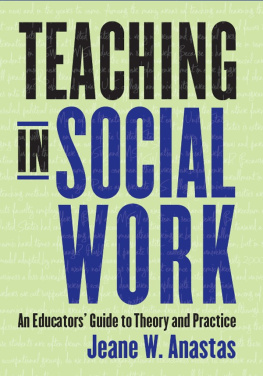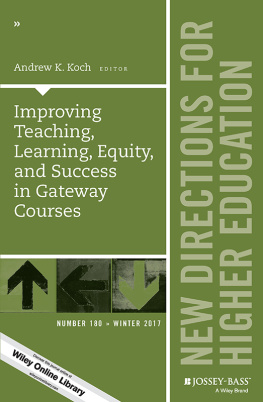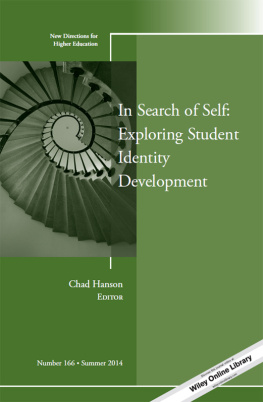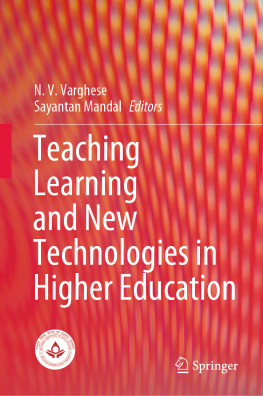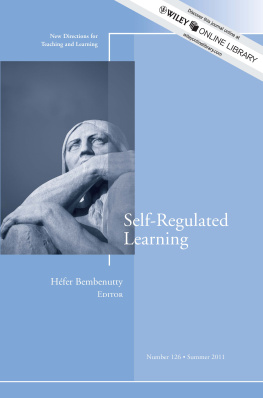
MULTIDISCIPLINARY COLLABORATION: RESEARCH AND RELATIONSHIPS
Karen Weller Swanson (ed.)
New Directions for Teaching and Learning, no. 139
Catherine M. Wehlburg, EditorinChief
Copyright 2014 Wiley Periodicals, Inc., A Wiley Company. All rights reserved. No part of this publication may be reproduced, stored in a retrieval system, or transmitted in any form or by any means, electronic, mechanical, photocopying, recording, scanning, or otherwise, except as permitted under Section 107 or 108 of the 1976 United States Copyright Act, without either the prior written permission of the Publisher or authorization through payment of the appropriate per-copy fee to the Copyright Clearance Center, 222 Rosewood Drive, Danvers, MA 01923, (978) 750-8400, fax (978) 646-8600. Requests to the Publisher for permission should be addressed to the Permissions Department, c/o John Wiley & Sons, Inc., 111 River St., Hoboken, NJ 07030; (201) 748-8789, fax (201) 748-6326, http://www.wiley.com/go/permissions.
Microfilm copies of issues and articles are available in 16 mm and 35 mm, as well as microfiche in 105 mm, through University Microfilms, Inc., 300 North Zeeb Road, Ann Arbor, MI 48106-1346.
New Directions for Teaching and Learning (ISSN 0271-0633, electronic ISSN 1536-0768) is part of The Jossey-Bass Higher and Adult Education Series and is published quarterly by Wiley Subscription Services, Inc., A Wiley Company, at Jossey-Bass, One Montgomery Street, Suite 1200, San Francisco, CA 94104-4594. POSTMASTER: Send address changes to New Directions for Teaching and Learning, Jossey-Bass, One Montgomery Street, Suite 1200, San Francisco, CA 94104-4594.
New Directions for Teaching and Learning is indexed in CIJE: Current Index to Journals in Education (ERIC), Contents Pages in Education (T&F), Educational Research Abstracts Online (T&F), ERIC Database (Education Resources Information Center), Higher Education Abstracts (Claremont Graduate University), and SCOPUS (Elsevier).
Individual Subscription Rate (in USD): $89 per year US/Can/Mex, $113 rest of world; institutional subscription rate: $311 US, $351 Can/Mex, $385 rest of world. Single copy rate: $29. Electronic onlyall regions: $89 individual, $311 institutional; Print & ElectronicUS: $98 individual, $357 institutional; Print & ElectronicCan/Mex: $98 individual, $397 institutional; Print & Electronicrest of world: $122 individual, $431 institutional.
Editorial correspondence should be sent to the editor-in-chief, Catherine M. Wehlburg, .
www.josseybass.com
From the Series Editor
About This Publication
Since 1980, New Directions for Teaching and Learning (NDTL) has brought a unique blend of theory, research, and practice to leaders in postsecondary education. NDTL sourcebooks strive not only for solid substance but also for timeliness, compactness, and accessibility.
The series has four goals: to inform readers about current and future directions in teaching and learning in postsecondary education, to illuminate the context that shapes these new directions, to illustrate these new direction through examples from real settings, and to propose ways in which these new directions can still be incorporated into other settings.
This publication reflects the view that teaching deserves respect as a high form of scholarship. We believe that significant scholarship is conducted not only by researchers who report results of empirical investigations but also by practitioners who share disciplinary reflections about teaching. Contributors to NDTL approach questions of teaching and learning as seriously as they approach substantive questions in their own disciplines, and they deal not only with pedagogical issues but also with the intellectual and social context in which these issues arise. Authors deal on the one hand with theory and research and on the other with practice, and they translate from research and theory to practice and back again.
About This Volume
The Scholarship of Teaching and Learning (SoTL) has been a movement in higher education for many years. This volume of New Directions for Teaching and Learning has as its focus SoTL and how collaborations among and between disciplines can strengthen education and the ways in which students are taught. The community of scholars that exists at any institution can provide a fertile ground for interdisciplinary collaboration that can enliven the educational process and the research that supports it. The chapters within this volume are written by individuals from many different disciplines who teach and who use SoTL to inform their own practice and as a method to share what they have done with others.
Catherine M. Wehlburg
EditorinChief
Foreword
The impact of the movement we have come to call the Scholarship of Teaching and Learning (SoTL) can be measured in terms of its products and the processes that yielded them. In terms of products, we now have a significant number of journals, some with an international focus. We have an impressive range of influential books written by Carnegie scholars and many others. We look to these and other products to make our teaching more scholarly.
Equally important for me are the processes by which these publications and other products come to be. In this regard, I have always considered it of paramount importance that what we might call distal workthat which is conducted at other institutions around the worldbe complemented by local work conducted in our own backyardsour home institutions and departments. This brings us to Multidisciplinary Collaboration: Research and Relationships.
Local work has local relevance and authenticity, and these are extremely valuable for scholarly approaches to teaching. Even more vital is the fact that engaging in local SoTL work builds communities of practice in this area and adds measurably to an institution's teaching culture. To this end, those of us who work in SoTL envision institutions in which SoTL work is the norm. It is an integral part of what a reflective institution and its practitioners do. This is why I am so encouraged by Multidisciplinary Collaboration: Research and Relationships. Here we see reflection and research about teaching brought to life at one institution.
As we read Multidisciplinary Collaboration: Research and Relationships, I invite us to ask if this type of SoTL community is thriving at our institutions. We might also ask what it takes to create and sustain such a community. Certainly, administrative support is essential. With this in mind, it is very encouraging to see that one of the contributing authors in Multidisciplinary Collaboration: Research and Relationships was Mercer University's provost, Wallace Daniel.
Of course, if volumes like Multidisciplinary Collaboration: Research and Relationships help build a community, we must ask who is included in such a community. The broad range of disciplines represented in this volume is very impressive in this regard. I am especially pleased to see that librarians perspectives are included. We have much to learn from librarians regarding teaching and SoTL, and it is very encouraging to read in that chapter that librarians want to be part of the learning processes that SoTL affords.
It is worth noting that a number of authors in this volume address the notion of signature pedagogies. Signature pedagogies provide both an important context for SoTL and an opportunity to look critically at that pedagogy. The authors of this volume are to be applauded for doing both.
It is one thing to describe and affirm common practice as found in signature pedagogies. It is something else again to use SoTL methods to examine, and perhaps challenge, what may be the status quo, as a number of these authors have done, especially in the area of student supervision. This examination takes some courage, and it is why I am so impressed with the chapters in this volume that take this on. This is how we affirm who we are as teachers and improve at the same time.
Next page


